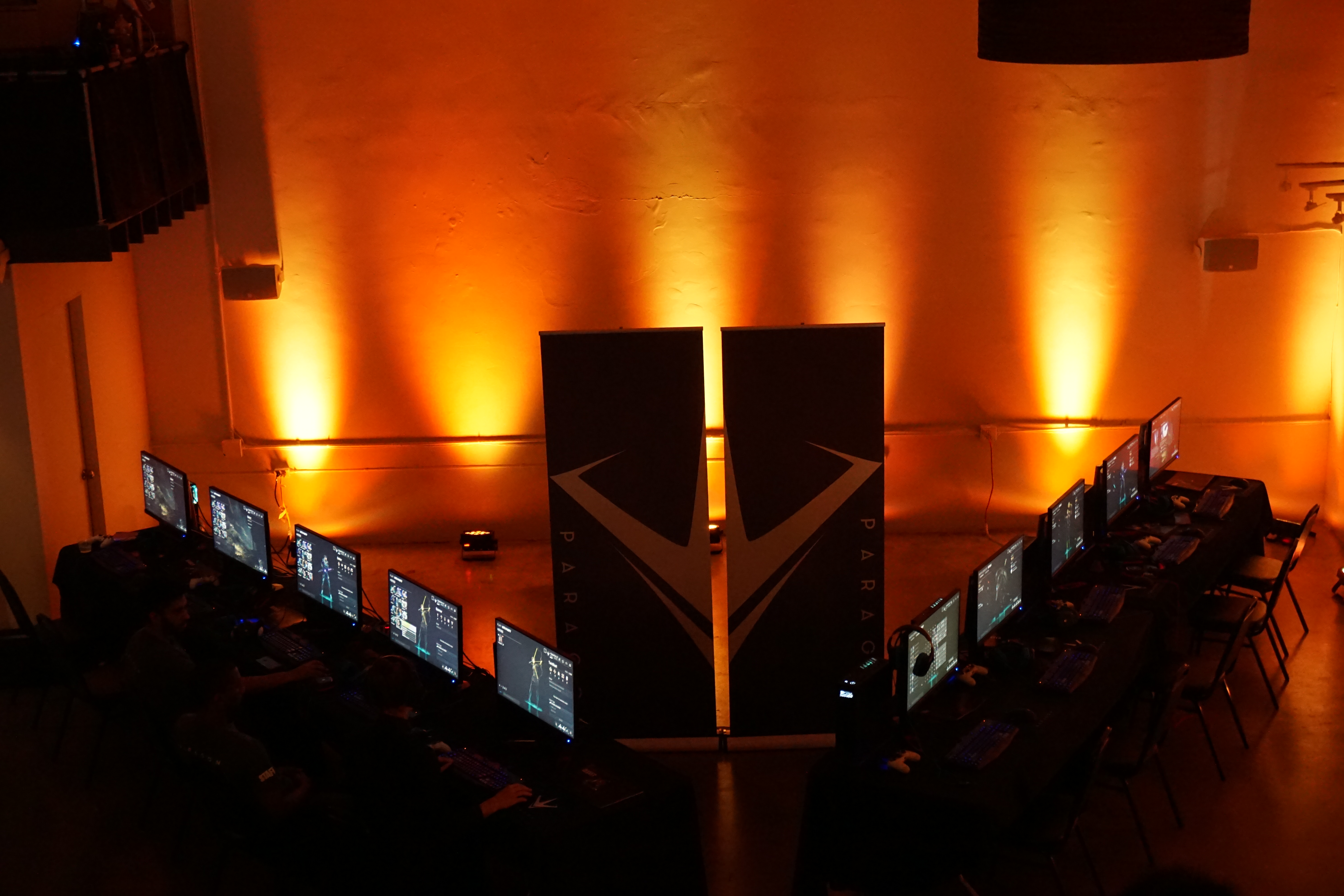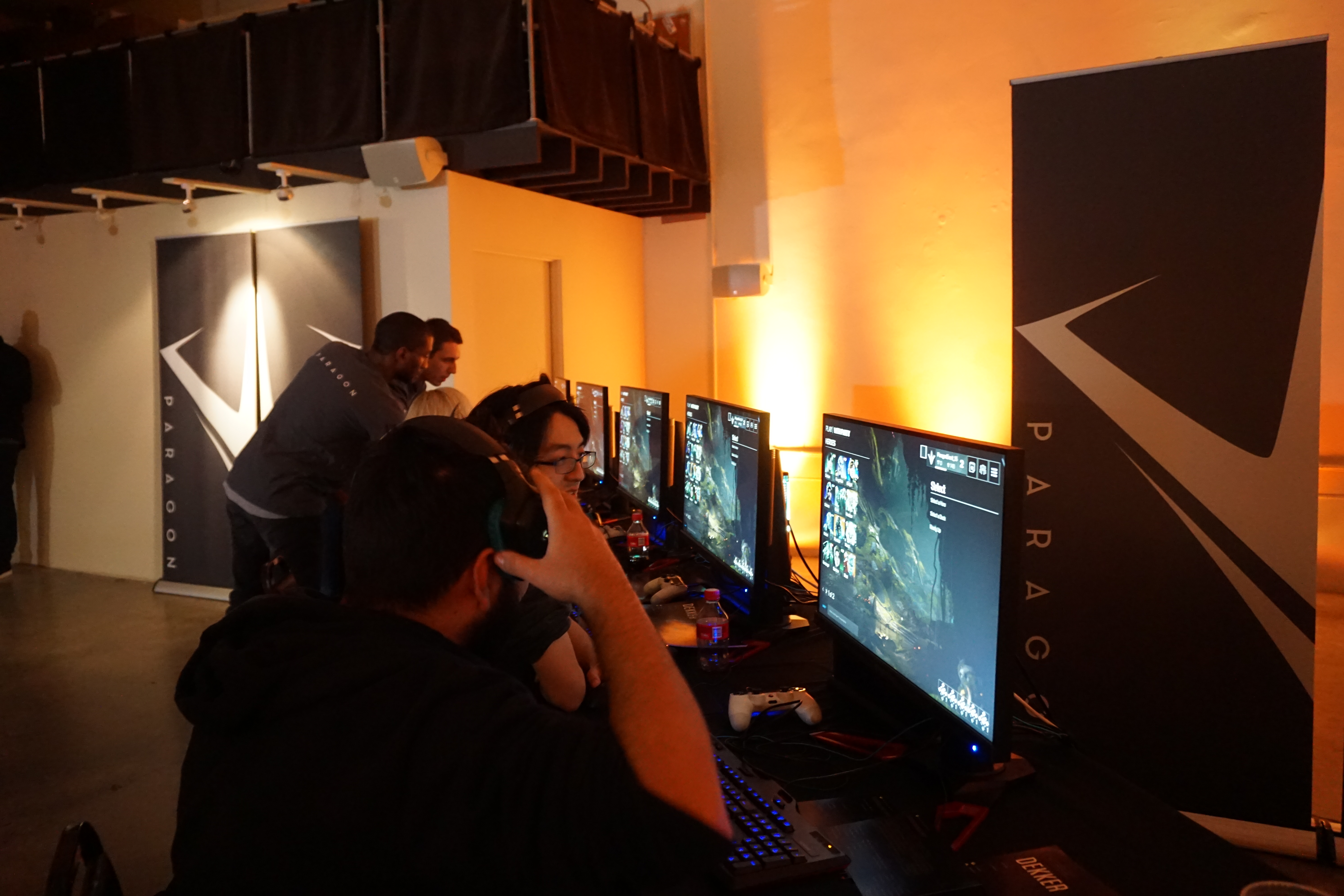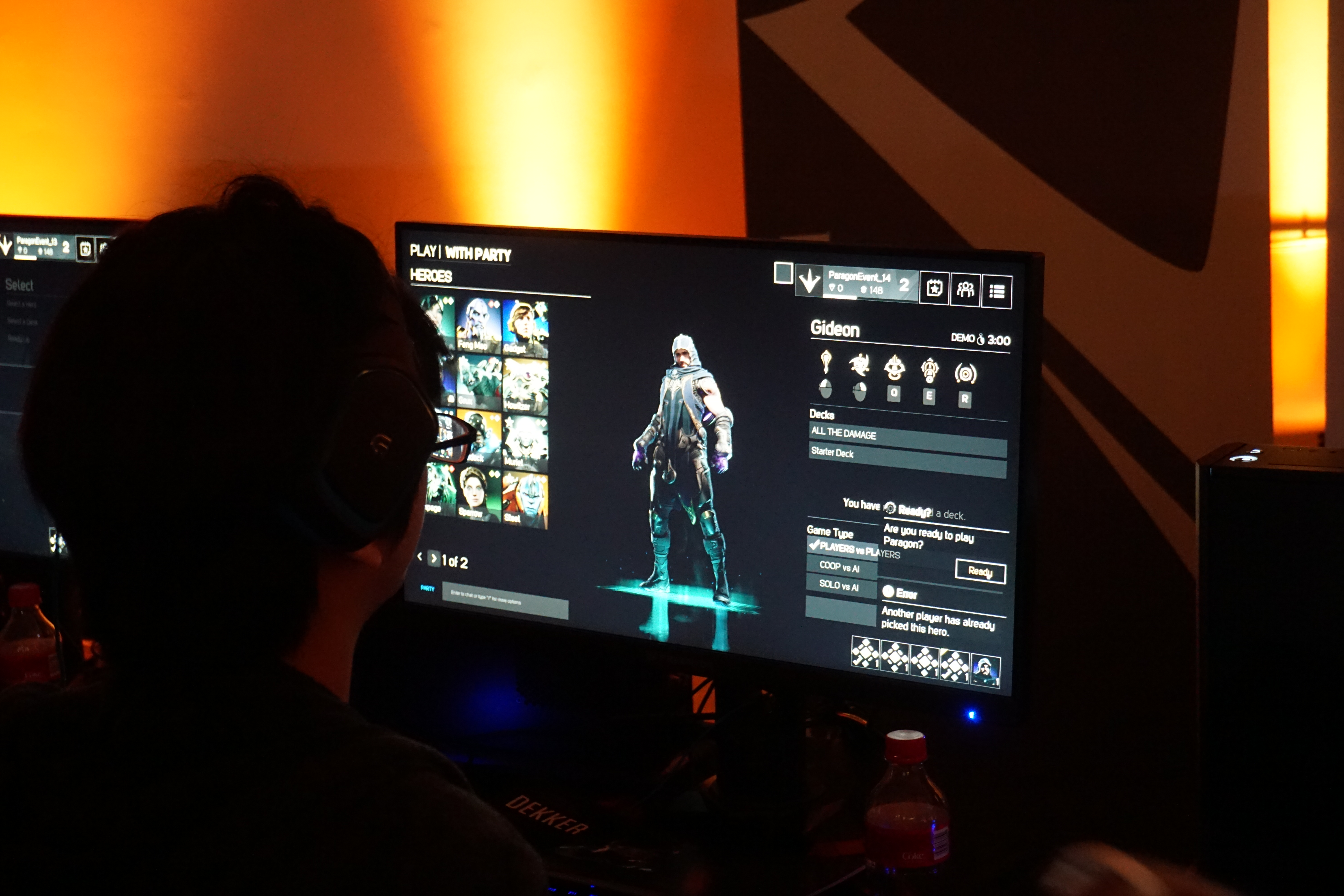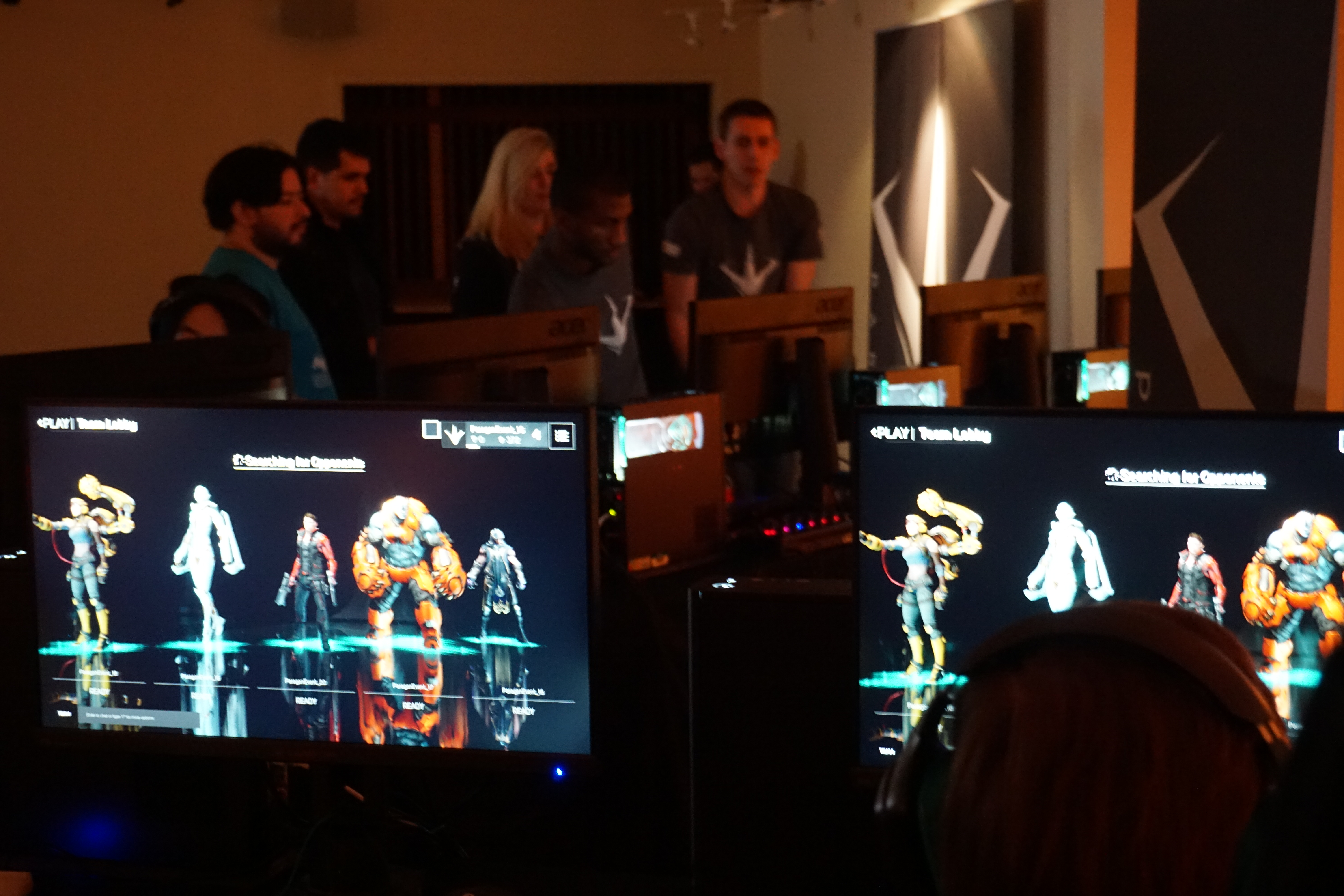Preview Of 'Paragon' By Epic Games, Founders Packs Available Today
Nowadays, MOBAs (multiplayer online battle arena) are a dime a dozen. Big names like League of Legends, Dota 2 and Heroes of the Storm have staying power thanks to their established developers. The same isn’t always true for MOBAs developed by smaller studios. However, Epic Games, the developer behind Unreal Tournament and Gears of War, isn’t new to the gaming industry. Epic clearly takes pride in presenting Paragon and has the tools for a successful launch; the only question is whether Epic has what it takes to make Paragon last.
Easing Into Paragon
Last week, Epic Games invited me and a handful of others to iam8bit in Los Angeles to preview a build of Paragon. Once everyone had arrived, we were split into four groups of five, with two groups playing against each other on PC and the other two groups playing on the PS4. Epic did their best to balance each team based on their familiarity with the MOBA genre.
The first match was our introductory game, and I played as Muriel, a support character. I’ve played MOBAs in the past, so it took only a minute or so to get used to the controls. One thing to note is that whereas MOBAs traditionally use the QWER keys as skills, because Paragon is a third-person shooter, the W key is replaced with the right mouse button, and the WASD keys are used to move.
Muriel’s right-click shoots an orb toward your reticle, which can be picked up for a shield and speed boost. Her Q skill shoots a projectile damaging and slowing enemies in a line. Her E skill is an AoE (area of effect) buff that shields allies and damages enemies. Finally, Muriel’s ultimate skill (R key) allows her fly to any ally on the map and shield them while pushing enemies back and shielding other nearby allies.
Unfortunately, my team lost our first round.
Deck Construction
Before our next match, Epic introduced us to deck creation, which determine each player’s upgrade path in-game. In the game lobby, players may construct a deck of up to 40 cards. Each deck must contain a Prime Helix Card, The Archmagus, The Centurion, or The Warlord, each of which offers players different stats. The rest of the deck consists of Equipment Cards and Upgrade Cards.
Equipment Cards come with upgrade slots. Let’s take Adamant Edge, for example, which has three upgrade slots. This card adds 7.6 Physical Damage and 125 Max Health. You may add up to three Upgrade cards -- let’s say two Lesser Healths, which offer 100 Max Health, and a Major Strike, which offers 22.7 Physical Damage. Placing these three Upgrade Cards into Adamant Edge’s slots will give a player 200 Max Health and 22.7 Physical Damage on top of Adamant Edge’s 7.6 Physical Damage and 125 Max Health. Additionally, because all three of Adamant Edge’s slots have been used, the card has been maxed out, giving Adamant Edge a bonus 15.2 Physical Damage.
Get Tom's Hardware's best news and in-depth reviews, straight to your inbox.
Upgrade Cards may only be installed based on an Equipment Card’s attributes. For example, Adamant Edge can use Max Health and Physical Damage upgrades only. Once your deck is ready, you can choose it during character selection prior to starting a match. While in a match, players earn Amber from defeating jungle mobs and minions. (Amber is the in-match currency that contributes to players’ card points, which are needed to purchase the cards in their decks.)
Advanced Play And Teamwork
With my custom deck ready, I jumped into another match as Sparrow, a ranged ADC (attack damage carry) character. Sparrow’s right click charges an arrow and shoots it over a great distance when released. Her Q skill damages enemies in a target area over time with a barrage of arrows. Sparrow's E skill is an attack speed steroid that allows her to move at travel speed (in MOBAs, a steroid is a skill that increases a character’s stats.) Finally, Sparrow’s ultimate skill allows her to shoot multiple arrows with each auto attack. Activating her E skill before her ultimate allowed me to melt through the enemy during team fights, and my team easily secured a victory.
Many more matches were had that day and the rest of the weekend. Once everyone understood how the deck system worked and which characters' skills synergized well, a few guys from Epic hopped on and joined the fun. (Indeed, for a game that still needs to be polished, Paragon was fun.) Playing with Epic felt less like we were testing a game and more like we were having a competitive LAN party. During my brief time playing, I took note of the addictive qualities that the most successful MOBAs have today.
Made For Everyone, And Coming Soon To Everyone
Paragon has a wide range of complexity. On the basic level, the gameplay is easy enough that anyone can jump straight in, whether they’ve played MOBAs or shooters in the past or haven’t played very many games at all. On the flip side, Epic has provided the tools necessary for highly competitive play, such as character synergies and a deep build customization shop through the deck system.
Finally, Epic also insisted that Paragon will have a free-to-play, but not pay-to-win, model. The Deck system allows advancement only by playing the game, meaning no one can jump into the game, throw down a wad of cash and dominate their peers. Monetary purchases will revolve around cosmetic items such as skins and emotes. All signs show that Epic wants Paragon to be the next big MOBA, and in an oversaturated market, it’s nice to see that Epic’s contender has the potential to be more than just a another copycat.
Paragon is expected to release some time this year, but Epic has yet to comment on a final release date. Founder’s Packs are available today, which will allow players paid early access starting March 18. For those who want to try Paragon for free, the open beta begins this summer.
Alexander Quejado is an Associate Contributing Writer for Tom's Hardware and Tom's IT Pro. Follow him on Twitter and Facebook.
Tom's Hardware is the leading destination for hardcore computer enthusiasts. We cover everything from processors to 3D printers, single-board computers, SSDs and high-end gaming rigs, empowering readers to make the most of the tech they love, keep up on the latest developments and buy the right gear. Our staff has more than 100 years of combined experience covering news, solving tech problems and reviewing components and systems.
-
Edward85 A bit surprised they are going for a Third Person Shooter, I don't think they are popular on PC. Consoles enjoy them sure. A look at the founders packs it reminds me a bit of Mech Warrior Online. You can already see there are "boosts" I guess to your XP and level your characters. Money will still be an important part in winning. I stopped playing Mech Warrior as too much became needing to have slots etc.Reply
Also boosts... "Monetary purchases will revolve around cosmetic items such as skins and emotes." do they just boost your ability to get a new hat? -
superfreestyleer ReplyShooters are popular on PC, very popular.
He is saying third person shooters though. Most PC ones are first person. -
fuzz0r Reply
I totally agree with you that they're primarily first person. But there are great third person games out there. And quite a few.17662355 said:Shooters are popular on PC, very popular.
He is saying third person shooters though. Most PC ones are first person. -
AndrewJacksonZA Reply
Not only are there quite a few, but for me, I prefer third person to first person.
I totally agree with you that they're primarily first person. But there are great third person games out there. And quite a few.17662355 said:Shooters are popular on PC, very popular.
He is saying third person shooters though. Most PC ones are first person. -
Achoo22 Ugh. I hope the future of gaming doesn't revolve around playing online-only games with little boys that I have nothing in common with. Also, free-to-play games seem to draw the scum of the earth as their player-bases.Reply -
Marcus52 Buying early access to an online game is buying the most buggy time of the game after release (can you say "server issues"?). If you have other reasons to buy a Founder's Pack, go for it - but don't do it for the early access. :)Reply -
RipperjackAU "Free-to-Play" games are always NEVER free!Reply
They will make you pay one way or another, with most of the time you spending more than your typical boxed "Pay-to-Play" game. :heink: -
DrakeFS Reply"Free-to-Play" games are always NEVER free!
They will make you pay one way or another, with most of the time you spending more than your typical boxed "Pay-to-Play" game. :heink:
There are exceptions, however only one stands out to me.
League of Legends would disagree with you... Seriously, I know some people spend a lot more on LoL than $60. However, I would say most LoL players are like myself and under $20 spent. Hell, most probably haven't spent a dime.




